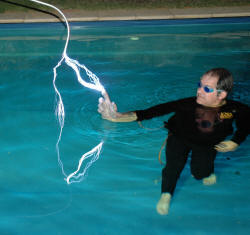http://www.msnbc.msn.com/id/27436310/
Great Lakes eyed for offshore wind farms
100,000 turbines could provide third of electricity needs for entire U.S.
TRAVERSE CITY, Mich. - Imagine sections of the Great Lakes dotted with rows of gleaming, 12-story turbines, blades whirring in the stiff breeze as they generate electricity for homes and businesses onshore.
It's only an idea — for now. But government regulators are bracing for an expected wave of proposals for offshore power generation in a region that never seems to run short of wind.
Despite its allure as a plentiful source of clean energy, they say, offshore wind power could affect the aquatic environment and commerce. State and federal officials are taking initial steps toward writing rules, as conservation activists watch closely.
"This is our last frontier, our wild west," said Jennifer Nalbone, navigation and invasive species director for the advocacy group Great Lakes United.
"Renewable energy is the direction we want go, but you don't want to enter it blindly."
Insiders reported on the situation this week during the International Submerged Lands Management Conference in Traverse City.
They said anchoring large wind farms on Great Lakes bottomlands would have implications for commercial and recreational navigation, water quality, fish habitat and even flight patterns for birds and aircraft.
'Huge amount of risk'
Wind power developers are wondering what kinds of regulatory hurdles they will encounter once they propose offshore projects, said John Cherry, a University of Michigan researcher studying the subject for the Great Lakes Commission.
"It's an unknown, so there's a huge amount of risk," Cherry said. "Everybody would like to be the second program to do it. The first will be a regulatory trailblazer."
Denmark, Sweden, the United Kingdom, the Netherlands and Ireland have installed offshore turbines, and Germany has approved nearly two dozen projects expected to go online soon. Denmark's largest wind farm has 80 turbines roughly 120 feet high, planted 8 to 12 miles off the coast.
The U.S. has no offshore wind production, although projects are in the works for Atlantic waters off Texas, Delaware, New Jersey and Rhode Island. A feasibility study is under way for a possible wind farm in Lake Erie near Cleveland.
A Michigan State University study released this month said Michigan's portion of the Great Lakes could produce nearly 322,000 megawatts of power from wind — a huge sum equal to roughly one-third of all electricity now generated nationwide.
Harnessing that much power would require placing nearly 100,000 turbines in the lakes, a remote prospect. Still, the study illustrated wind power's considerable potential for the region.
"There is interest in the Great Lakes, and I know some companies are looking there," Laurie Jodziewicz, manager of siting policy for the American Wind Energy Association, said in a phone interview.
Turf battles possible
The lakes would present unique challenges, such as ice cover in winter, she said. Developers also worry about excessive regulatory hoops with eight states and two Canadian provinces having jurisdiction. The U.S. Army Corps of Engineers also might get involved.
Michigan's Department of Environmental Quality processed a mock application earlier this year, said Tom Graf, a specialist in the Land and Water Management Division. Officials concluded legislation might be needed to deal with questions such as where turbines could be placed and leasing rates for use of Great Lakes bottomlands.
"We may find we don't have the authority to address a lot of these issues," Graf said.
The Great Lakes states have a solid legal basis for imposing tough regulation of offshore wind energy, said Chris Shafer, a professor with the Thomas M. Cooley School of Law in Lansing. It's rooted in the doctrine that Great Lakes bottomlands are held in trust for the citizens.
He urged the states to get started on designating sites that would be off-limits to turbines, such as shipping lanes, bird migration corridors and fish spawning sites. Michigan's Institute for Fisheries Research is developing a system to identify such locations, analyst Minako Kimura said.
The states also should require companies to pay a fair market value for use of public resources, Shafer said.
"It's entirely too easy to consider that a free resource that should be provided to the energy industry," he said.





